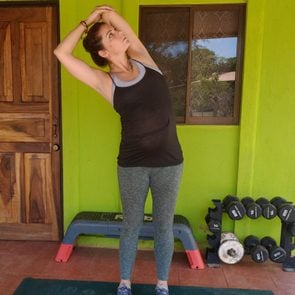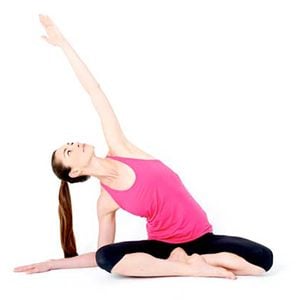A Daily Stretching Routine for People Short on Time
Updated: Jun. 10, 2021
Increase your range of motion, reduce your risk for injuries, lower stress, and simply feel good with this daily stretching routine. Plus—you can squeeze it in anytime and anywhere.
The case for a daily stretching routine
Whether you sit at a desk all day or stand and move around from nine to five, a daily stretching routine can help you feel good.
Maintaining a regular stretching routine can increase your range of motion, warm you up for more intense exercise, and even stave off aches and pains, says Chelsea Long, an exercise physiologist at the Hospital for Special Surgery in New York City.
Even if you’re perpetually crunched for time, you can squeeze in a few stretches that will benefit your entire body in just a few minutes.
Check out why you should stretch every day and which moves will help you get loose and feel calm.
What are the benefits of daily stretching?
A stretch a day keeps the doctor away. That might not be the exact adage, but it’s a good rule to live by.
Stretching can benefit both your physical and mental health.
Increases range of motion
This type of stretching, which involves holding a stretch for 30 seconds or more, can relieve tightness and help you move around better.
“Static stretching, when done consistently, increases flexibility and range of motion,” says Long. “Lots of bodily aches are due to a tightness of some variety that creates an issue somewhere else.”
For example, lower back pain—a condition that will affect 80 percent of the population at some point in their lives—can come from tight hip flexors and a weakened core.
Adefemi A. Betiku, a physical therapist, certified strength and conditioning specialist, and certified Pilates teacher, says static stretching is particularly good for relieving tense, tight areas. But he suggests doing a mix of both static and dynamic stretching for your daily routine to gain the most advantages from activity and holds.
Prevents injury
Tightness and lack of range of motion in your joints can force you to compensate for that limited mobility, leading to stress and overuse of a different muscle or side of the body, Long explains.
This can lead to either an acute or chronic injury. But a regular stretch session can help you sidestep those issues, as it supports better movement patterns.
Dynamic stretching, in which you move in and out of a stretch, only pausing for a few seconds, can also help increase body temperature, enhance blood flow, and get the body revved for more movement, Long says.
“When the body is stiff and immobile in our beds or chairs and we ask it to start running or lifting under a load, it’s not prepared,” she says. “And that puts it at risk of injury, like muscle strains, cramps, or spasms.”
That’s why you want to do dynamic stretching before a workout. You can also do dynamic stretching throughout the day simply to squeeze in more movement and help the body become healthier overall.
Calms the body and mind
Besides those physical payoffs, stretching can also be meditative. “It’s a time to decompress and relax the body,” Long says.
How to stretch safely
The goal of stretching is to start slowly, easing into each stretch without forcing any position.
“Keep in mind when stretching that you are gradually lengthening your muscles,” Long says. “Reaching full range of motion in any movement does not happen without preparing it, or you can injure and strain the muscle.”
Taking deep breaths will help you ease into poses. Long suggests thinking about it as preparing for the stretch on the inhale and going a little deeper on each exhale.
“Many of us forget that breathing has a voluntary component, and you can control it,” she says. “It’s helpful when exercising to control heart rate and pace, but it’s also helpful when stretching through tough movements and tight spots. It can make your stretching feel more productive, decrease your blood pressure, and give you a sense of calm.”
She warns that you may be sore after a dedicated stretching session because you’re forcing your muscles into an eccentric lengthening phase. You shouldn’t feel pain, but the typical soreness you might get from another type of workout is normal.
Finally, to see results, you need to keep your stretching consistent, Long says. That’s why it’s smart to get in a habit of doing daily stretches.

7 stretches to do every day
For a full routine you can do right out of bed in the morning—or anytime throughout the day—Betiku recommends seven simple stretches.
Repeat the list for about three rounds. If you finish this list and want more, Long suggests adding moves like shoulder rolls and knee hugs to the lineup.
Windshield wipers
Start by lying on your back with your knees bent and together. Keep your feet flat on the floor and together.
Drop both knees to one side, keeping your torso steady and shoulders flat on the floor.
Bring your knees through the center of your body to the other side.
Repeat for 10 to 20 reps on each side. Hold on one side for 30 seconds, then hold on the other side for 30 seconds.
Book openers
Lie on your left side on the floor. Keep your knees and hips stacked and bent 90 degrees. Extend your arms straight out in front of you, keeping them stacked.
Open your top (right) arm, bringing it to the other side of the body and as close to the floor as you can without the left shoulder lifting or your hips rotating. Your knees and hips should remain stacked.
Bring your right arm back to the original position. Repeat for 20 reps. On the last rep, hold the stretch for 30 seconds.
Repeat on the other side.
Pec stretch
Stand in the middle of a doorway and lift both arms to shoulder height. Move your arms out to your sides, so your upper arms and body form a T. Place your forearms on the door frame or wall.
Step forward with one foot. If the stretch feels too intense, bring the arms a little lower than a T position.
Hold the stretch here for 30 seconds.
Shoulders towel stretch
Grab a towel and hold it in one hand overhead so the towel drapes down your back.
Tuck your other arm behind your lower back to grab the other end of the towel.
Pull the top arm upward to increase the stretch in the lower arm. Hold for 30 seconds.
Pull the bottom arm downward to increase the stretch in the upper arm. Hold for 30 seconds.
Switch sides and repeat.
Chin tucks
Standing or seated in a chair while maintaining a tall posture, shoulders squared, slide your head back as if giving yourself a double chin. Keep your forehead steady (don’t tilt it up or down).
Release to neutral. Repeat for 10 to 20 reps.
Lateral neck stretch
Standing or seated in a chair while maintaining a tall posture, shoulders squared, lower your left ear toward your left shoulder. Use your left arm on the right side of your head to gently press your ear closer to your shoulder. Be careful not to tug too hard on your head.
Hold for 30 seconds, then switch sides.
Diagonal neck stretch
Standing or seated in a chair while maintaining a tall posture, shoulders squared, look halfway between the center of your body and left shoulder.
Turn your head down as if you’re moving to smell your armpit. Use your left hand to gently pull your head down.
Hold for 30 seconds, then switch sides.



